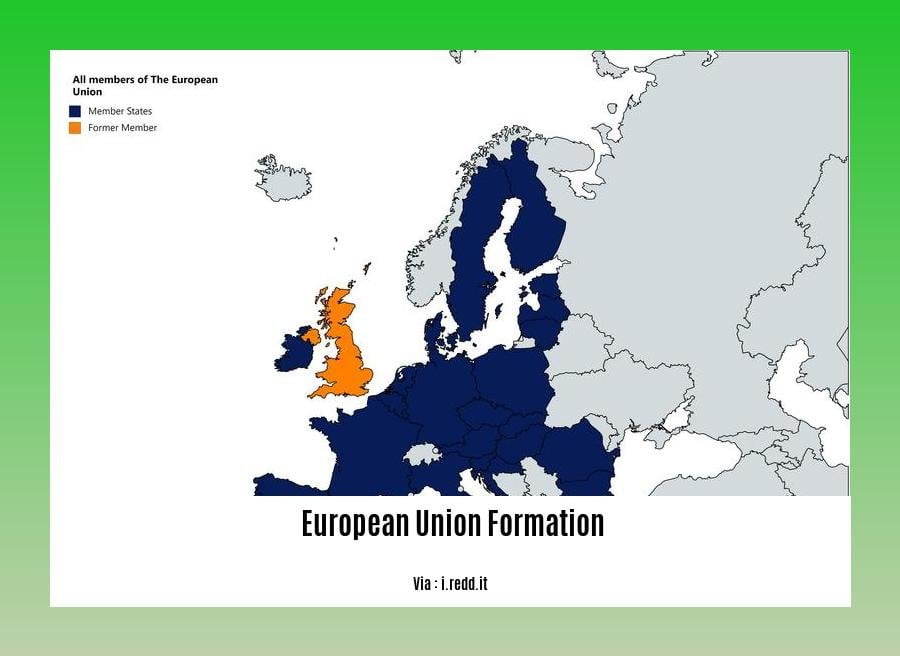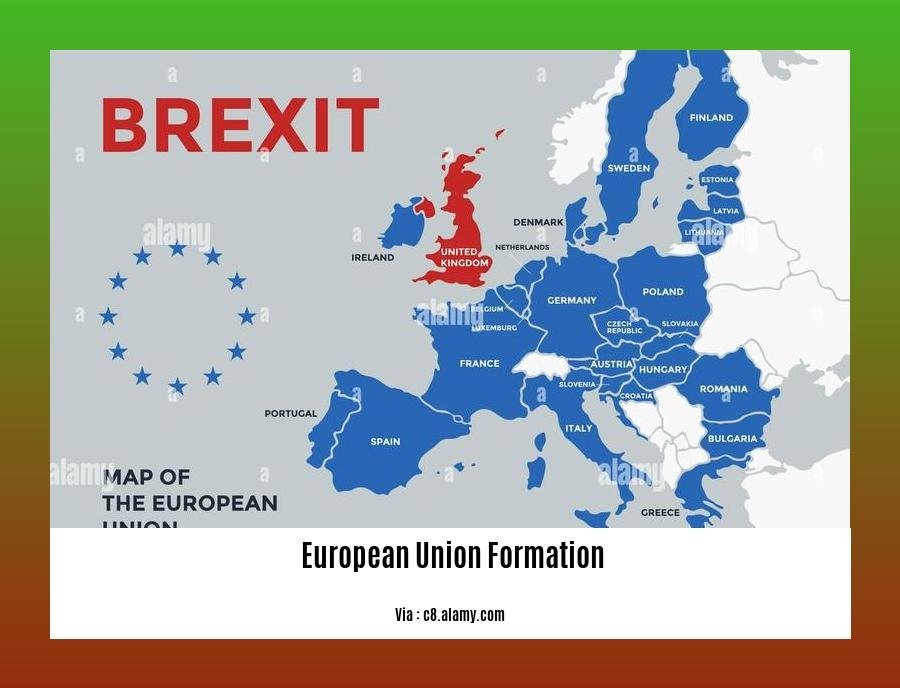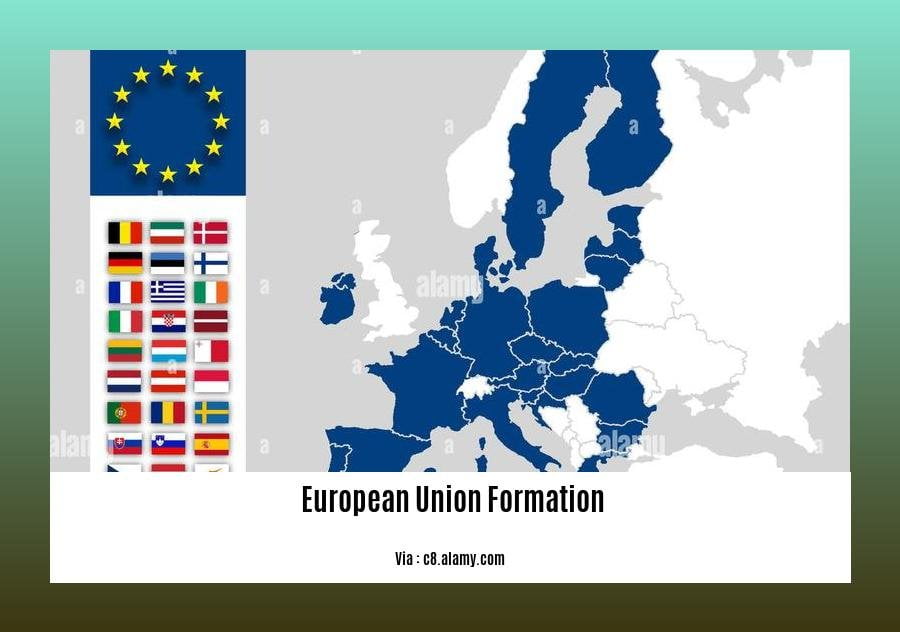Embark on a journey through time to unravel [The Genesis of European Unity: A Historical Perspective on European Union Formation]. This exploration delves into the tapestry of events that laid the foundation for the European Union, a beacon of unity and cooperation on the global stage.
Key Takeaways:
- Founded on November 1, 1993
- Consists of 27 member states
- Formed through the Maastricht Treaty
- Preceded by successful unions like the ECSC and EEC
- Promotes unity, stability, and economic growth among member states
European Union Formation:

Tracing the roots of the European Union formation is like embarking on a historical odyssey, where visionary leaders and transformative events converged to shape the destiny of Europe.
Antecedents of European Unity
The seeds of European unity were sown long before the European Union formation. The European Coal and Steel Community (ECSC), established in 1951, laid the groundwork for economic cooperation among six founding nations: Belgium, France, Germany, Italy, Luxembourg, and the Netherlands. The ECSC’s success paved the way for the European Economic Community (EEC) in 1957, further deepening economic integration.
The Maastricht Treaty: A Milestone in European Union Formation
The signing of the Maastricht Treaty in 1993 marked a pivotal moment in the European Union formation. This treaty established the European Union, transforming the EEC into a political and economic union. The treaty introduced a common currency, the euro, and strengthened cooperation in areas such as foreign policy, justice, and home affairs.
Guiding Principles of European Integration
The European Union formation was guided by several key principles:
- Unity: Fostering a sense of common identity and purpose among member states.
- Stability: Promoting peace and security through political and economic cooperation.
- Economic Growth: Enhancing prosperity and improving living standards through free trade and economic integration.
The European Union: A Dynamic and Evolving Entity
Since its inception, the European Union has undergone continuous evolution. Enlargement rounds have seen the membership grow from six to 27 nations. The EU has also faced challenges, including the global financial crisis, the migration crisis, and the UK’s withdrawal.
Despite these challenges, the European Union formation remains a testament to the power of cooperation and integration. Through its journey of unity, stability, and economic growth, the European Union continues to shape the destiny of Europe and beyond.
If you want to take a trip through time to check the grand chronicles of the magnificent continent, you must definitely dive deep into the History of Europe for a better understanding of the world we live in today. For those of you who are curious about the revival of arts, culture, and literature, don’t miss out on reading about The Renaissance in Europe. And, if you are more into influential ages, then you need to explore the Industrial Revolution’s impact on the shaping of modern society.
Institutional Evolution

Over the decades, the European Union (EU) has undergone a dynamic institutional evolution, transforming from a small group of nations to a global powerhouse. The EU’s journey has been driven by theories of European integration, with institutionalism playing a central role.
Key Milestones
1948: The seeds of the EU were sown with the establishment of the European Coal and Steel Community.
1993: The EU officially took shape with the adoption of the Maastricht Treaty, introducing the euro and deepening integration.
2007: The Lisbon Treaty expanded the EU’s powers and reformed its institutions, aiming to make it more responsive and democratic.
Structures and Functions
The EU’s institutional structure is multifaceted:
- European Parliament: The only directly elected body in the EU, representing citizens’ interests.
- European Council: Consists of heads of states or governments from member nations, determining the EU’s political agenda.
- Council of the European Union: Brings together ministers from each member state, responsible for specific policy areas.
- European Commission: The EU’s executive body, proposing and implementing policies.
Expansion and Challenges
The EU has grown from six founding members to 27, demonstrating the allure of unity and economic cooperation. However, this expansion has also brought challenges, such as managing diversity and reaching consensus among a larger group.
Future Prospects
The EU’s institutional evolution continues, with ongoing discussions on improving its efficiency and fulfilling its potential. Key topics of debate include strengthening the role of the European Parliament and maximizing the benefits of the Lisbon Treaty.
Key Takeaways:
- The EU has experienced significant institutional evolution since its inception.
- European integration theories have influenced the EU’s development and growth.
- The EU’s complex institutional structure promotes cooperation and unity.
- The EU’s expansion and secession reflect its dynamic nature.
- The EU’s future involves ongoing discussions on improving its institutions and policies.
Citations:
- The Institutional Architecture of the European Union: Emerging and Future Trends
- History of the European Union
Challenges and Reforms
The European Union (EU) is a cooperative effort of European countries that was forged out of the ashes of World War II to prevent future conflicts and promote economic integration. Today, the EU faces a number of Challenges and Reforms that could impact its stability and prosperity.
Challenges
The EU faces a number of challenges, including:
- Economic crises, such as the ongoing sovereign debt crisis in some member states
- Climate change
- Terrorism
- Migration
- Populism and Euroscepticism
Reforms
The EU is implementing a number of reforms to address these challenges, including:
- Economic reforms, such as the Stability and Growth Pact and the European Semester
- Climate change policies, such as the EU Emissions Trading System
- Anti-terrorism measures, such as the European Counter-Terrorism Centre
- Migration policies, such as the EU-Turkey deal
- Democratic reforms, such as the European Citizens’ Initiative
Key Takeaways:
- The EU faces a number of challenges, including economic crises, climate change, terrorism, migration, and populism.
- The EU is implementing a number of reforms to address these challenges, including economic reforms, climate change policies, anti-terrorism measures, migration policies, and democratic reforms.
- The EU’s Challenges and Reforms will shape the future of the bloc and its member states.
Relevant URL Sources:
- Challenges and Opportunities for the European Union
- The EU’s Future: Challenges and Reforms
Future Prospects
Unraveling the intricate tapestry of the European Union’s (EU) future trajectory requires navigating an ever-changing landscape shaped by both internal and external dynamics. The EU’s future prospects are inextricably intertwined with its ability to navigate ongoing challenges and seize emerging opportunities.
Key Challenges to the EU’s Future
- Armed conflicts: The ongoing war in Ukraine has laid bare the fragility of peace within Europe’s borders.
- Climate change: Climate-related disasters, such as extreme weather events and rising sea levels, pose significant threats to the EU’s environment, economy, and infrastructure.
- Cyberattacks: The digital realm has become a battleground, with the EU facing persistent threats from cybercriminals, state actors, and terrorist organizations.
- Economic instability: The global economic fallout from the COVID-19 pandemic and the ongoing war in Ukraine has exposed the EU’s vulnerability to external shocks.
- Migration: The influx of refugees and asylum seekers from war-torn regions and developing countries has created both humanitarian and political challenges for the EU.
The EU’s Strategic Priorities
The EU has identified several key priorities for its future development, outlined in its strategic agenda for 2019-2024:
- Protecting citizens: Ensuring the safety, security, and well-being of its citizens remains a top priority for the EU.
- Fostering economic growth: The EU aims to promote sustainable economic growth and job creation through innovation, investment, and trade.
- Promoting sustainability: Tackling climate change and transitioning to a greener, more sustainable economy are central to the EU’s future.
- Upholding European values globally: The EU seeks to continue playing a leading role in promoting democracy, human rights, and the rule of law around the world.
The Conference on the Future of Europe
In 2021, the EU launched the Conference on the Future of Europe, a citizen-led initiative to gather input on the EU’s future direction. The conference’s recommendations, based on extensive public consultations, will shape the EU’s policy agenda for years to come.
Key Takeaways:
- The EU faces significant challenges to its stability and prosperity, including armed conflicts, climate change, cyberattacks, economic instability, and migration.
- The EU has outlined strategic priorities for its future, focusing on protecting citizens, fostering economic growth, promoting sustainability, and upholding European values globally.
- The Conference on the Future of Europe has provided a platform for citizens to contribute to shaping the EU’s future direction.
Citation:
- CRS Reports: The European Union: Current Challenges and Future Prospects
- Modern Diplomacy: Future Opportunities, Threats, Challenges and Goals of the EU
FAQ
Q1: What was the impetus behind the formation of the European Union?
A1: The success of earlier unions (ECSC, EEC) and the desire to promote unity, stability, and economic growth among member states were key factors in the formation of the EU.
Q2: When was the European Union officially established?
A2: The European Union was founded on November 1, 1993, through the Maastricht Treaty.
Q3: How many member states make up the European Union?
A3: The European Union currently has 27 member states.
Q4: What are some of the key theories that have influenced European institutional evolution?
A4: European integration theories, historical institutionalism, sociological institutionalism, and the concept of “institutional entrepreneurship” have all played a role in shaping the EU’s institutional development.
Q5: What has been the driving force behind the EU’s expansion from six to 27 member states?
A5: The EU’s growth has been driven by a combination of expansions and secessions, reflecting the changing political, economic, and social landscape of Europe over time.
- China II Review: Delicious Food & Speedy Service - April 17, 2025
- Understand Virginia’s Flag: History & Debate - April 17, 2025
- Explore Long Island’s Map: Unique Regions & Insights - April 17, 2025
















